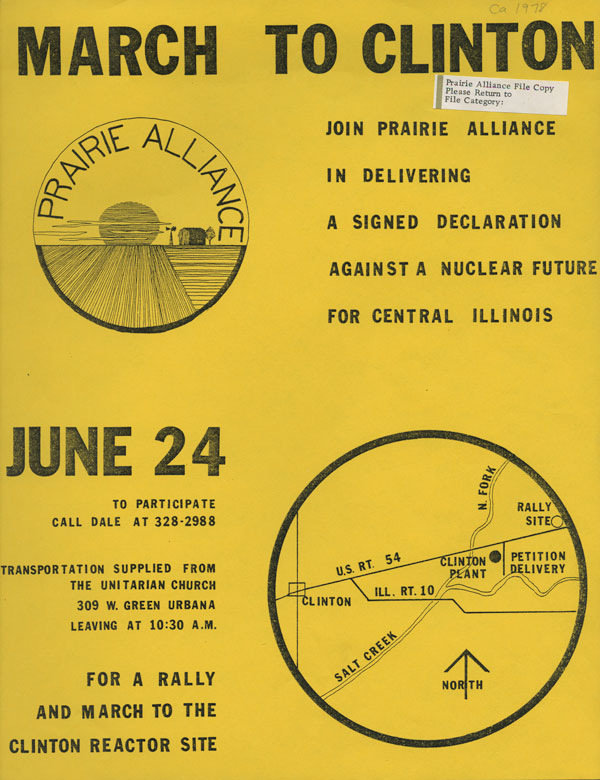In 1975, students of Lachlan F. Blair’s Environmental Planning Workshop wrote three working papers on the impact of a proposed Clinton, Illinois nuclear power plant. As Professor of Urbana Planning at the University, Blair’s workshop participants had the opportunity to work with the DeWitt County Regional Planning Commission to study particular aspects of the proposed site. These papers addressed the impact that the cancellation of the Clinton Power Plant would have on DeWitt County and was the impetus of a grass-roots organization opposing nuclear power in Central Illinois.

A few of the engineering students in this Workshop–Peter Penner, Charlotte Ford, and Randall Plant–formed Prairie Alliance, a grass-roots organization that stressed safe, economic, socially desirable alternatives to the planned nuclear power plant. “There is simply no need for Illinois Power to continue to pursue the nuclear option in this era of skyrocketing power costs and unprecedented regulatory uncertainty.”[1] Despite local protest, the Illinois Power Company began constructing one of two planned nuclear electric power plants (designated Clinton I and II) in 1976, with an estimated completion date of December, 1981.

In protest of ongoing construction, over 100 activists released 900 balloons from a site adjacent to the Clinton nuclear power plant on April 1, 1978.[2] Each of the balloons carried a card explaining the purpose of the demonstration–how radiation can disburse during a major power plant incident–and asked the finder to contact Prairie Alliance. More than 40 of the helium balloons released were found in nine states: Illinois, Indiana, Ohio, North Carolina, Kentucky, West Virginia, Tennessee, Virginia, and South Carolina. The long-distance record went to a balloon that landed near Myrtle Beach, South Carolina, less than 30 miles from the Atlantic Ocean, and around 700 miles from Clinton. The Kingstree, South Carolina News commented, “If you’re worried about all the nuclear activity going on in South Carolina, here’s one more worry to add to your list.”

Just a few months later, 23 Prairie Alliance members began a two day, 40-mile walk to the Clinton construction site. They carried a petition signed by citizens of Champaign, Urbana, Bloomington, Springfield, Mason City, and Clinton asking Illinois Power to cease construction of the Clinton plant. Other protestors from throughout Central Illinois joined the marchers for a rally featuring music and speakers on June 24, coordinating the event with nationwide anti-nuclear protests.
“The plants were originally estimated to cost 1 billion dollars and are now predicted to cost 1.7 billion,” but the cost far exceeded these estimations, in part because of delayed construction.[3] Prairie Alliance opposed the Clinton nuclear power plant throughout the central Illinois area from 1975 until 1982, educating the public and disseminating information about the uses and development of energy resources, promoting research on energy-related issues and making the research publicly available, organizing public forums for discussion, and presenting speakers, films and other programs concerned with energy and its uses. Despite their efforts, the Clinton nuclear generating station began service on April 24, 1987.
Twenty-seven years later, Exelon is considering closing the plant, as it has failed to turn a profit for the past five years.
[1] Press Release, November 26, 1979, Prairie Alliance Archives, 1974-82, Record Series 41/66/107, Box 1, Folder “Factsheets,” University Archives.
[2] Press Release, Prairie Alliance Archives, 1974-82, Record Series 41/66/107, Box 1, Folder “Clinton Balloon Release Material,” University Archives.
[3] Fact Sheet on the Clinton Nuclear Power Plant, Prairie Alliance Archives, 1974-82, Record Series 41/66/107, Box 1, Folder “Factsheets,” University Archives.